The design of traps
Making bee traps homemade you need to pay attention to such factors: the size of the trap, the smell, the richness of grasslands, the distance to the water.
What trap is better? According to some observations, the form does not make any difference. It should be convenient to lift and place on the tree for the beekeeper.
The main characteristics of the trap :
– trap can be made quickly;
– to make a trap you need a small amount of material;
– trap has a low weight;
– trap is easy to fill;
– trap is not bulky;
– trap is firmly put to the tree trunk;
– trap is easy to pull on the earth with the swarm.
You can use ready round barrel of plywood , which are used in industry. You just need to drill holes for the tap hole, sheathing the roof with roofing material, place in a trap frames with honeycombs.
Volume of traps
Bees measure the internal volume of future housing. They are not tempted to live in crowded conditions. But they do not like superfluous volume, especially since the large traps are inconvenient for tree climbing. Bees neglect small traps (20 liters). Only very small swarm in late July and August can sit in such traps. The first swarms in May and early June do not come in such traps.
Optimum volume for the trap – 40, 60 and 80 liters. You can also set traps in pairs of different sizes and see which of them will have success. If the trap is too large, you can make plywood ceiling and thus reduce the volume of trap.
Manufacturing traps
Traps for carpenter bees are made from three-ply or double fiberboard. Such a trap for bees is similar to the carrying box for frames, but has also cover as a hive.
Internal dimensions of the trap for bees:
Depth – 470 mm (18.5”) (length of a standard frame);
width (width standard frame with reamer – 37 mm):
5 frames – 190 mm (7.5”);
6 frames – 230 mm (9”);
7 frames – 265 mm (10.4”);
8 frames – 300 mm (11.8”);
9 frames – 340 mm (13.4”);
10 frames – 380 mm (15”).
The thickness of the front and rear walls of the trap for bees (swarms) – 20-24 mm (0.8-1”). For the walls, you can use put together pieces.
The thickness of the side walls of the trap for bees (swarms) – 3-4 mm (0.1”). The side walls of the trap can be made out of plywood.
Space for bees under the frames – 10-15 cm (4-6”).
Notches. Top notches – a round of 20-25 mm (0.8-1”) in diameter or lower notches (if necessary) – a width of 7-8 mm (0.3”). Then the hornets can not occupy it. Round notches are convenient for closing. After all, before you touch a trap with a swarm, it must be securely closed so that bees can not fly away. With slotted notch when you with one hand hold to the branches, and with the other, sometimes to the touch, plug it, it is very difficult.
Trap for bees (swarms) should be free of cracks, so that no one bee gets out when you lower it from the tree. Bees do not make out who is who. They claim the right to live where they like.
You can cover it with the bark of an old tree. You can not paint the rail under notch, but rub it with propolis.
You can make a trap of wicker or fine planks. Make the frame. Then it is wrapped with crust in two, three layers and sometimes four. Swarms like such dwelling. But such traps is better to do if you have a relationship to logging and you have the ability to use the bark of felled trees. Do not spoil live trees .
You can use small kegs of fine riveting. You only need to wash it well to remove odors.
Sometimes the trap is made of cardboard boxes of butter. Two of these boxes can be combined into one, but without gaps. Boxes must also be good evaporated, so that there are no oil stains.
Internal structure of the trap
Cylindrical trap. Frames can be placed vertically. Combs are mounted as usual. Attach it to a distance of 5-10 cm (2-4”) from the bottom. It depends on the height of the entire trap, how much space you used under frames. In round trap you need to wrap the upper edge with an old cotton cloth, gauze or anything else. Otherwise bees find a hole in almost any ceiling. Tight binding of the top of trap hold bees.
Quadrangle trap. Framework should be hung on the shoulders, as in a beehive. For trap for bees use standard Dadan frame. Number of frames in the trap for bees – from 5 to 8.
You can also use body frame. Even small swarms can use it.
It is desirable to use the framework with the connected side bars. Then they do not hang out, which is also important. They can even break combs. Bees then glue them with propolis, wax, build the cell where it is necessary and where not. After all, the longer the transplant, the more bees fall in the grass. Straightening the skewed frameworks, you break brood cells. You can hurt the queen. Therefore, the frames should be securely fastened. If even trap falls, frame structure should not be violated.
There are frameless techniques of traps , but they are not recommended due to obvious deficiencies. Now times have changed and combs became available. Therefore, you should fill the frame with full honeycombs. The sooner bees finish to build combs, the sooner they start to collect nectar.
You should drizzle combs with syrup of average concentration – 150 grams of sugar per 100 grams of water. Such a solution you use for both sides. Sprinkle it with syrup or with honey diluted in water you should in any case whether many frameworks or few. Then the bees almost twice faster rebuilt the honeycomb cells.
Inside the trap for bees it is preferably to put on the edge of the frame the old cells (for smell).
Sometimes the bees start to chew the inner walls of the trap for bees. In this case, you can fill the trap wall for bees with a thin layer of wax .
Framework should be covered with a piece of an old jacket. This is done not only for warmth. Often the bees do not want to rebuild the honeycombs, especially if manufacturing was treated negligently. If you put a ceiling, it should be laid right on the frameworks.
So the streets are laid on top of rails, then – cloth, then – plastic film, then – the roof.
The roof is attached to the body of the trap for bees with girth haywire. This wire must be strong enough so that it can raise a trap for bees to the height.
How to paint a trap?
Better to paint a trap for bees from the outside with oil paints in the autumn, so to the spring smell will be weathered. The paint protects the plywood and cardboard from cracking and disintegration. But unpainted traps for bees of plywood can be used for more than ten seasons.
Paint trap, for example, with green paint.
Quick-drying paint is not recommended for dyeing traps for bees. It retains its sharp and unpleasant smell for a long time and the plywood is often shelled.
You can paint the trap bees with grass. Take quinoa, garden buttercup, nettle, burdock. Rub the outer walls along the fibers of the wood and across. When the plywood dries, it gets dirty-green color. Bees come even better to such traps for bees. Here the paint is not only guard against moisture, but also attracts bees by its natural color and smell of pine. Grass painting can stay for three summers.
The main thing that nobody can notice the trap on the tree.
Do not paint inside. The walls become impermeable to air, do not absorb moisture. In case of sharp temperature fluctuations walls will sweat, and stable humidity appears.
Methods of attracting of bees with smell
Bees have a well developed sense of smell. They like cleaness, odor and volume. Bees do not like the fresh smell of dry wood. So you can put new traps without a roof a couple of times at the rain. After they lose scent of freshness.
You can also treat the inside of the trap for bees with certain substances to attract a swarm.
You can rub the trap inside with juicy lemon balm, black currant leaves, pine needles, a garden grass. If grated with lemon balm trap stays about a month, then the number of brood of such family can be more than in another swarms in the apiary. Trap, standing on the pine-tree, does not need to be treated in the winter from the tick. Volatile of pine suppress mite.
You can put in one of the frames the piece of drone brood. You can also put in a trap a small number of pollen and sealed honey. However, the trap with honey cannot be put near the settlements and livestocks. About a kilometer around them there is a lot of flies. They feel the odor of traps, climb in, and can bring any infection.
You can also rub inside with queen cells, and not only traps, but also new hives.
Trap for bees from the inside can be heated with a blowtorch, and rub with a piece of wax and fluff edges with dissolved in alcohol propolis.
You can put a piece of sugar into the trap.
You can put on the bottom of the trap for swarms of bees a piece of rotten wood. But it must be dry and free of dust and specks. Perhaps bees recently settled in the hollows, and they have not lost the love to the smell of rotted wood.
Take the ether for anesthesia, gather fresh gum of pine trees and dissolve it in the ether. Then rub this solution inside and on the wooden frame parts. Ether evaporates in 20-30 minutes, and there is a pleasant smell of tar, attractive to bees.
Edge of the tap hole and around you can rub with wax and honey.

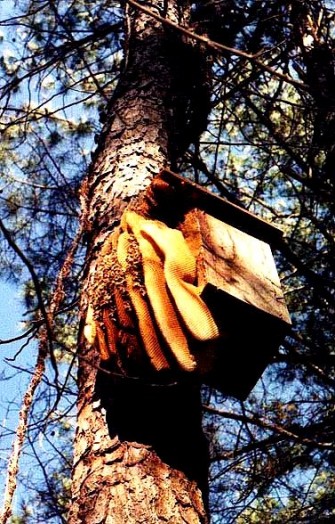

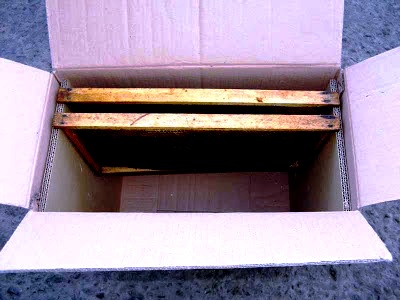
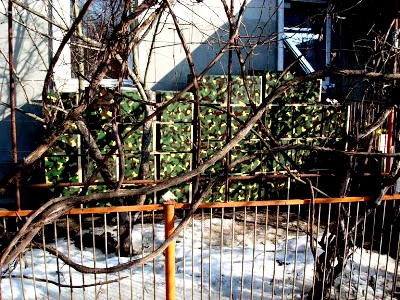

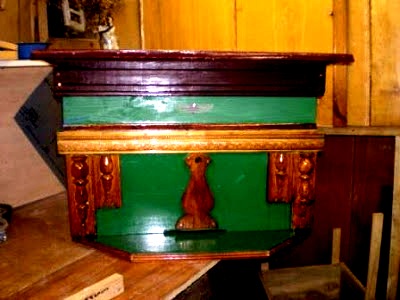

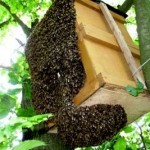
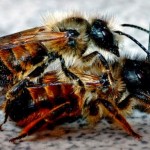
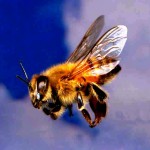
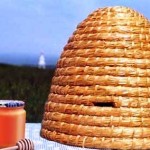
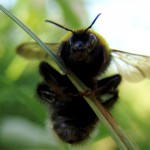
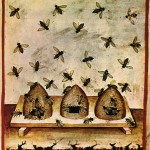
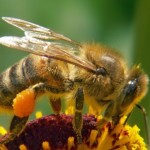
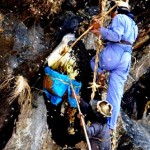


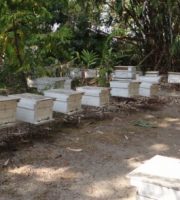
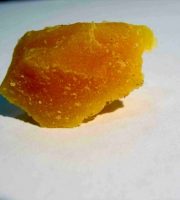
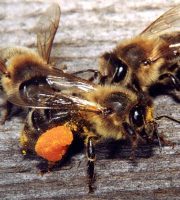
Bee traps homemade